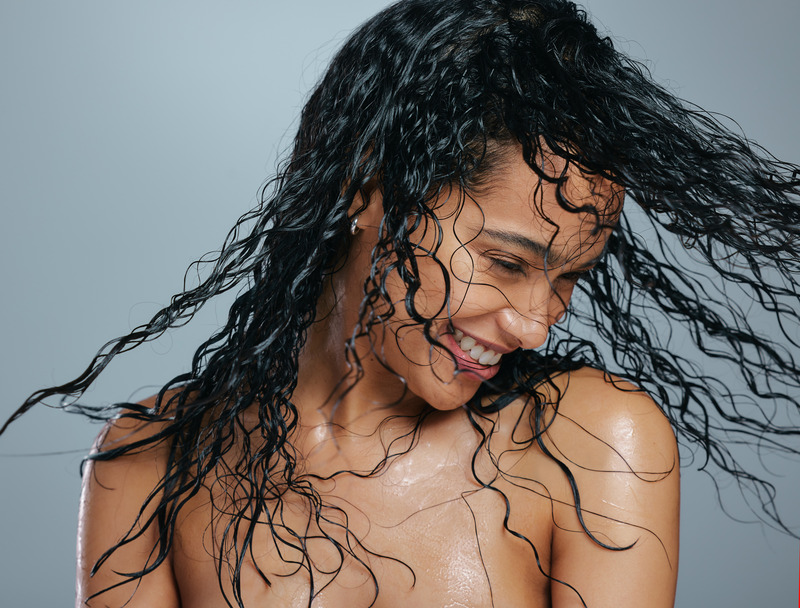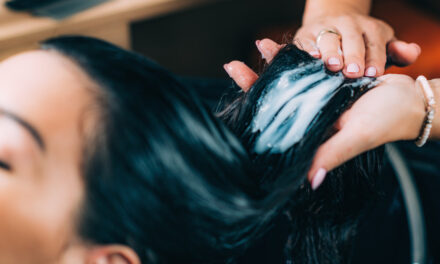
Welcome to your comprehensive guide on deep conditioning treatments for low-porosity hair! In this blog post, we dive deep into the essentials of nurturing and maintaining low-porosity hair, guaranteeing it receives the optimal moisture and care it deserves.
Whether you’re an experienced hair care enthusiast or just starting to unravel your hair’s unique needs, this all-encompassing guide delivers invaluable insights and actionable tips to revolutionize your hair care regimen.
Understanding Low Porosity Hair
Low porosity hair is characterized by hair strands with tightly bound cuticles that lie flat, posing a significant challenge for moisture, water, and hair care products to penetrate the hair shaft. This hair type is renowned for its propensity to repel moisture and retain its dryness, frequently leading to products remaining on the hair’s surface instead of being absorbed.
Unlike high-porosity hair, which readily absorbs and loses moisture, low-hair porosity demands specific care to hydrate and nourish the natural hair effectively.
Signs You Have Low Porosity Hair
Low porosity hair is characterized by its tightly bound cuticles, which lay flat against the hair shaft. This structure makes it difficult for moisture, oils, and other hair care products to penetrate the hair, leading to various challenges in maintaining hydration.
Recognizing the signs of low porosity hair is the first step towards adopting a hair care regimen that addresses these unique needs effectively. If you’re wondering whether you have low porosity hair, here are some key indicators:
- Limited Moisture Absorption: Your hair takes a long time to get thoroughly wet in the shower and slowly dries. The tightly closed cuticles block water from quickly entering and exiting the hair shaft.
- Products Sit on Hair: After applying hair products, you might notice that they tend to sit on top of your hair rather than being absorbed. This can leave your hair feeling greasy or laden with product, despite how much you try to work it in.
- Lack of Elasticity: Your hair may lack flexibility, making it hard to stretch without breaking. This brittleness is a sign of under-moisturized hair, a common issue for those with low porosity strands.
- Challenges with Wash Day: Washing your hair becomes a lengthy process, not because of the steps involved but due to how your hair interacts with water and products. You may find that shampoos and conditioners don’t quickly rinse out, or your hair feels unclean even after a thorough wash.
- Water Beading: When in contact with water, droplets may bead up and roll off your hair rather than soaking in. This phenomenon further illustrates the difficulty moisture has in penetrating low-porosity hair.
How to Deep Condition Low Porosity Hair

Step 1. Wash with Clarifying Shampoo
The initial step in deep conditioning low-porosity hair involves guaranteeing your dry hair is devoid of buildup. A clarifying shampoo is essential for eliminating residues from hair care products, oils, and minerals from hard water that may have settled on your hair and scalp.
This process ensures a pristine base, rendering your wet hair significantly more receptive to the deep conditioning treatment, enhancing its effectiveness, and ensuring optimal hydration and nourishment.
Tip: Choose an effective yet gentle clarifying shampoo to avoid stripping your hair of its natural oils.
Step 2. Dry Gently with Towel
After washing your hair, taking the step to gently towel-dry it is crucial, especially when dealing with low porosity hair that tends to hold onto water on its outer layer rather than absorb it. This excess water can act as a barrier, preventing the deep conditioner from penetrating the hair shaft effectively, which is essential for nourishing and hydrating the hair from within.
Tip: By using a soft, absorbent towel or a microfiber cloth to press and blot the water from your hair lightly, you not only reduce the risk of mechanical damage but also prepare your hair to receive the full benefits of the deep conditioning treatment, ensuring that the product can deeply nourish your strands.
Step 3. Condition Deeply
Choosing the right deep conditioner for low-porosity hair is pivotal in ensuring your hair receives the hydration it needs. Formulations designed specifically for low-porosity hair contain ingredients capable of penetrating the tightly sealed cuticles, often a barrier to moisture absorption in this hair type.
By generously applying such a conditioner, primarily concentrating on the ends of your hair where damage and wear are most pronounced, you can significantly improve moisture retention and enhance the overall health of your hair. This strategic application helps your hair retain moisture and absorb moisture, ensuring it stays hydrated and healthy.
Tip: Look for deep conditioners with humectants, emollients, and ingredients like glycerin, honey, and certain alcohols that draw moisture into the hair.
Step 4. Apply Heat for Penetration
Integrating heat into your deep conditioning routine can dramatically enhance the efficacy of treatments for low-porosity hair. Encasing your hair with a plastic cap and applying a mild, steady heat source—whether through a hooded dryer, a heat cap explicitly designed for this purpose, or a warm towel—can effectively prompt the hair’s cuticles to open.
This crucial lifting of the cuticles is vital for addressing the hair’s porosity, as it enables deep conditioning agents to deeply infiltrate the hair shaft, guaranteeing that moisture and nutrients are efficiently absorbed and retained in the areas most in need.
Tip: Monitor your hair throughout this process to ensure it doesn’t become too hot. The goal is to warm your hair slightly to open up the cuticles, not to overheat it.
Step 5. Rinse and Seal Cuticles
Washing out deep conditioner with lukewarm water plays a pivotal role in maintaining low-porosity hair, eliminating product buildup without subjecting the hair to extreme temperature shifts that could lead to damage. This careful temperature management is crucial for preserving the hair cuticles’ integrity, which can remain lifted and vulnerable to moisture loss if subjected to excessive heat.
Concluding the conditioning routine with a cool water rinse is ideal, especially for hair with difficulty absorbing moisture. This last step ensures the cuticles are sealed, securely locking moisture within the hair shaft and imparting a smooth, lustrous finish to low and medium-porosity hair types.
Tip: Avoid using hot water for the final rinse, as it can raise the cuticles, leading to moisture loss and potential frizz.
Step 6. Incorporate Hot Oils
Integrating hot oil treatments into your hair care regimen can dramatically transform the health and appearance of low-porosity hair. Oils like grapeseed, jojoba, argan, almond, coconut, and avocado are particularly beneficial for this hair type, as they possess unique properties that penetrate the hair’s tightly bound cuticles.
When warmed and applied to the hair, these oils become even more effective, working to coax the cuticles open gently. This process not only aids in the deeper penetration of moisture during the deep conditioning phase but also helps in locking in hydration, ensuring that your hair retains the nourishment it receives.
Tip: Making hot oil treatments a regular part of your hair care routine can significantly enhance moisture absorption, leading to softer, more pliable hair that radiates health from the inside out.
Common Mistakes to Avoid
When caring for low-porosity hair, certain practices can inadvertently lead to more harm than good. Avoiding these common mistakes can significantly improve your hair’s health and appearance:
- Over-conditioning and protein overload can lead to brittle hair.
- Using products that are too heavy can cause buildup.
- Skipping regular clarifying sessions.
- Neglecting to use heat when deep conditioning.
- Not utilizing a sealing oil after moisturizing.
- Forgetting to detangle gently to prevent breakage.
- Avoiding regular trims, leading to split ends.
Tips for Maintaining Low Porosity Hair

Maintaining low-porosity hair involves adopting practices that enhance moisture absorption, minimize protein overload, and keep the hair healthy and manageable. Here are some essential tips to help you care for your low-porosity hair effectively:
- Regularly clarify your hair to prevent buildup.
- Opt for lightweight oils and moisturizers that won’t weigh your hair down.
- Embrace protective styles to minimize mechanical damage and heat use.
- Incorporate a balanced diet rich in vitamins and minerals for healthy hair.
- Stay consistent with your hair care routine to see improvements.
- Experiment with different products and techniques to find what works best for you.
- Keep your hair hydrated by drinking plenty of water.
Bottom Line
Deep conditioning low-porosity hair requires patience, understanding, and the proper techniques to ensure your hair receives the moisture it needs. By following the steps outlined in this guide, avoiding common mistakes, and incorporating our tips for maintenance, you can achieve hydrated, healthy-looking hair.
Remember, every hair journey is unique, so don’t be afraid to experiment and find what works best for your individual hair needs. And if you want to boost your hair, consider trying Vitamins Revive to support your hair’s health from the inside out.
FAQs
Can you use rice water on low-porosity hair?
Yes, rice water can be used on low-porosity hair, but it’s essential to use it sparingly and not too frequently to avoid protein overload, making the hair stiff and brittle. Rice water is rich in amino acids and vitamins that can help strengthen hair, but moderation is key.
How often should you deep condition low porosity hair?
Deep conditioning low porosity hair should be done every 1 to 2 weeks, depending on your hair’s needs and how well it retains moisture. Finding a balance is crucial to avoid over-moisturizing and causing buildup.
Is coconut oil good for low-porosity hair?
Coconut oil can be heavy for low-porosity hair and may not be the best choice as it can sit on the hair’s surface and lead to buildup. Instead, lighter oils like argan or grapeseed oil might be more beneficial for penetrating and moisturizing low-porosity hair strands.









